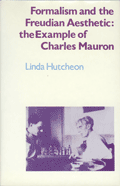Formalism and the Freudian Aesthetic:
the Example of Charles Mauron
As its doubled title suggests, this study has two purposes. It charts the parallel reevaluation of both formalism and psychology in twentieth-century literary theory by using the work and career of the French critic, Charles Mauron (1899-1966), as a scaffolding. Secondly, it addresses the broader issues of objectivity and subjectivity in literary criticism. Mauron is best known today as the formulator of a psychoanalytic theory called
psychocritique , an "empirical aesthetic" developed out of a strict formalism (influenced by Bloomsbury formalist painter and theorist, Roger Fry, and by his own early training in science) combined with a Freudian and Kleinian psychoanalytic theory of creation and response. The wider context of this study is that of the contemporary yet eternal debate regarding the designation of literary criticism as a precise and objective science or as the ultimate subjective, that is, human and humane act.
Table of Contents
Introduction
Part I: The Critical Formation: Science, Formalism, and Aesthetic Contemplation
Chapter One: Early Roots: Science, Bloomsbury, and Roger Fry
Chapter Two: The Attraction of Formalism
Chapter Three: Art and Science
Chapter Four: Toward Psychocritique : From 'Spiritual' to 'Psychological'
Part II: Psychoanalysis and Literary Criticism
Chapter Five: Scientific Psychology and Art
Chapter Six: Psychoanalysis and Psychocritique
Chapter Seven: Psychocritique : Formalism, Science, and the Value of Problems
Chapter Eight: Psychocritique and the Modern French Critical Context
Conclusion
Appendix
